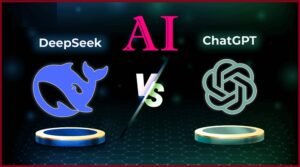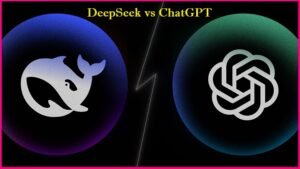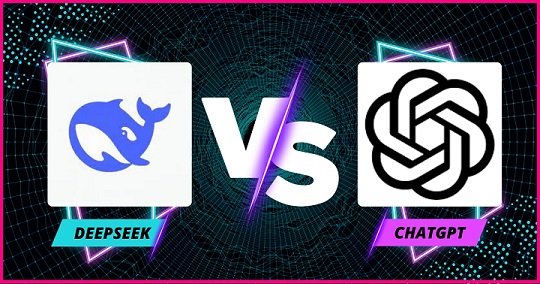DeepSeek vs ChatGPT (2025): The Ultimate AI Comparison
Artificial intelligence (AI) has rapidly transformed the digital landscape, and among the frontrunners in this space are DeepSeek and ChatGPT. Whether you’re a developer, content creator, business owner, or an AI enthusiast, choosing the right AI language model is essential. In this comprehensive guide, we compare two of the most popular AI models: DeepSeek vs ChatGPT.
This article covers their features, performance, pricing, use cases, and much more to help you make an informed decision.
1. Introduction to DeepSeek and ChatGPT
What is DeepSeek?
DeepSeek is an open-source large language model (LLM) developed in China. It is gaining popularity for its flexibility, support for multiple languages, and self-hosting capabilities. DeepSeek aims to rival Western models by offering a highly customizable and scalable solution for both individuals and enterprises.
What is ChatGPT?
ChatGPT is a conversational AI developed by OpenAI, based on its Generative Pre-trained Transformer (GPT) architecture. As of 2025, it includes models like GPT-3.5 and GPT-4 Turbo. ChatGPT is widely used for writing, coding, customer service, research, and more. Its integrations with tools like DALL-E and voice assistants make it highly versatile.
2. Technology Overview

| Feature | DeepSeek | ChatGPT |
|---|---|---|
| Developer | DeepSeek Team (China) | OpenAI (USA) |
| Model Size | 67 Billion parameters (v2) | 175 Billion (GPT-4 est.) |
| Architecture | Transformer (Decoder-only) | Transformer (Decoder-only) |
| Open Source | Yes | No |
| Deployment | Self-hosted/Cloud | Cloud via OpenAI |
| Training Dataset | Multilingual, Chinese focused | Broad internet corpus |
DeepSeek is designed with transparency in mind, while ChatGPT focuses on accessibility and scalability.
3. Language Capabilities
| Language Support | DeepSeek | ChatGPT |
| Primary Language | Chinese | English |
| Multilingual | Moderate | Advanced (30+ languages) |
| Translation | Basic | High Accuracy |
| Context Handling | Limited | Strong |
ChatGPT stands out in multilingual capabilities, making it ideal for global users.
4. Performance Analysis
When it comes to generating content, both models show promise. However, their outputs vary significantly.
| Criteria | DeepSeek | ChatGPT |
| Content Quality | Good in Chinese, fair in English | Excellent across languages |
| Creativity | Moderate | High |
| Context Retention | Medium | High |
| Summarization | Moderate | Excellent |
| Academic Use | Good for translation | Excellent for all purposes |
ChatGPT excels in natural language processing, especially in English-language tasks.
5. Coding & Developer Support
| Feature | DeepSeek | ChatGPT |
| Language Support | Python, C++, Java | 20+ languages |
| Code Suggestions | Basic | Advanced |
| Code Debugging | Limited | Excellent |
| Plugin Support | No | Yes |
| API Integration | Via Hugging Face | OpenAI API |
ChatGPT is better suited for developers seeking real-time, multi-language programming support.
6. Use Cases
DeepSeek
- Best for Chinese enterprises
- Academic translation
- Localized chatbot development
ChatGPT
- Content creation
- Customer service automation
- Coding assistant
- Multilingual communication
- Research and summarization
ChatGPT provides broader applications for both personal and professional tasks.
7. Pricing Comparison
| Plan | DeepSeek | ChatGPT |
| Free Version | Yes (self-hosted) | Yes (GPT-3.5) |
| Paid Plan | None | $20/month (GPT-4 Turbo) |
| API Cost | Free with self-hosting | Pay-as-you-go via OpenAI |
| Licensing | Apache 2.0 | Proprietary |
DeepSeek is more cost-effective for developers with technical knowledge, while ChatGPT offers plug-and-play simplicity.
8. Feature Comparison Table

| Feature | DeepSeek | ChatGPT (GPT-4 Turbo) |
| Open Source | ✅ | ❌ |
| Plugin Support | ❌ | ✅ |
| Image Generation | ❌ | ✅ (via DALL-E) |
| Voice Input/Output | ❌ | ✅ (via ChatGPT Mobile App) |
| Custom Instructions | ❌ | ✅ |
| Personalization | ❌ | ✅ (Memory-enabled) |
| Security Control | ✅ | Moderate |
ChatGPT is feature-rich and user-friendly, while DeepSeek appeals to developers and researchers.
9. Pros and Cons
DeepSeek
Pros:
- Open-source and customizable
- No recurring cost
- Good for Chinese content
- Can be deployed locally
Cons:
- Limited English capability
- No image/voice support
- Requires technical expertise
ChatGPT
Pros:
- Superior language understanding
- Multimodal support
- Easy to use
- High-quality responses
Cons:
- Monthly cost for GPT-4
- Not open source
10. Which One Should You Choose?
Choose DeepSeek if:
- You need an open-source solution
- You want to run the model locally
- Your focus is on Chinese language tasks
Choose ChatGPT if:
- You want an out-of-the-box solution
- You work in multiple languages
- You need tools for content, coding, and productivity
For most users, ChatGPT offers a more complete, versatile, and scalable solution. However, DeepSeek is a great alternative for those needing open-source flexibility.
11. Frequently Asked Questions
Q1. Is DeepSeek completely free?
Yes, DeepSeek is open-source and free to use under the Apache 2.0 license.
Q2. Can DeepSeek compete with GPT-4 in English tasks?
No, its performance is best in Chinese. GPT-4 is superior in English content creation.
Q3. Can I integrate DeepSeek into my app?
Yes, but it requires self-hosting and developer knowledge.
Q4. Does ChatGPT support voice and image features?
Yes, via the mobile app and integrated DALL-E support.
Q5. Is ChatGPT worth the $20 per month?
For professionals, yes. It provides significant value across tasks.
Final Thoughts
Both DeepSeek and ChatGPT are excellent tools, but their ideal users are very different. DeepSeek empowers technically skilled users and enterprises in need of open-source, localized AI. ChatGPT, on the other hand, provides seamless AI solutions across industries, supported by a growing ecosystem of features.
Related Posts:


